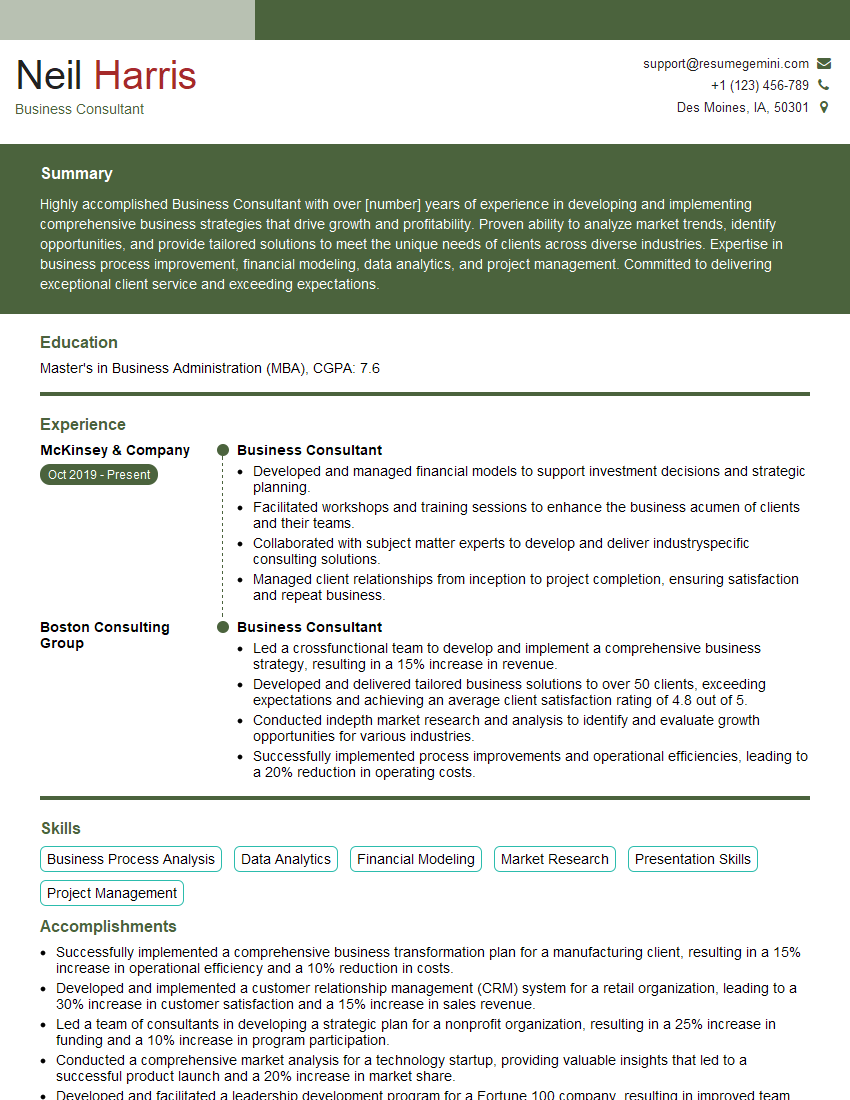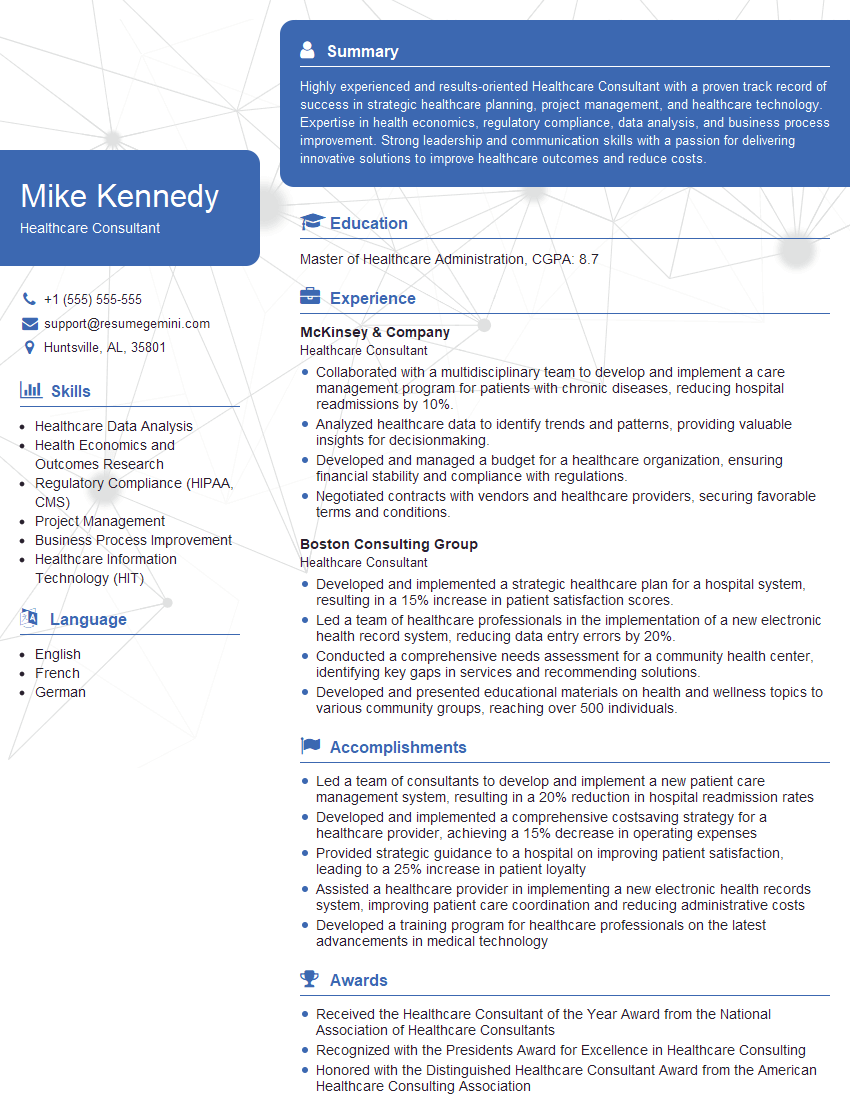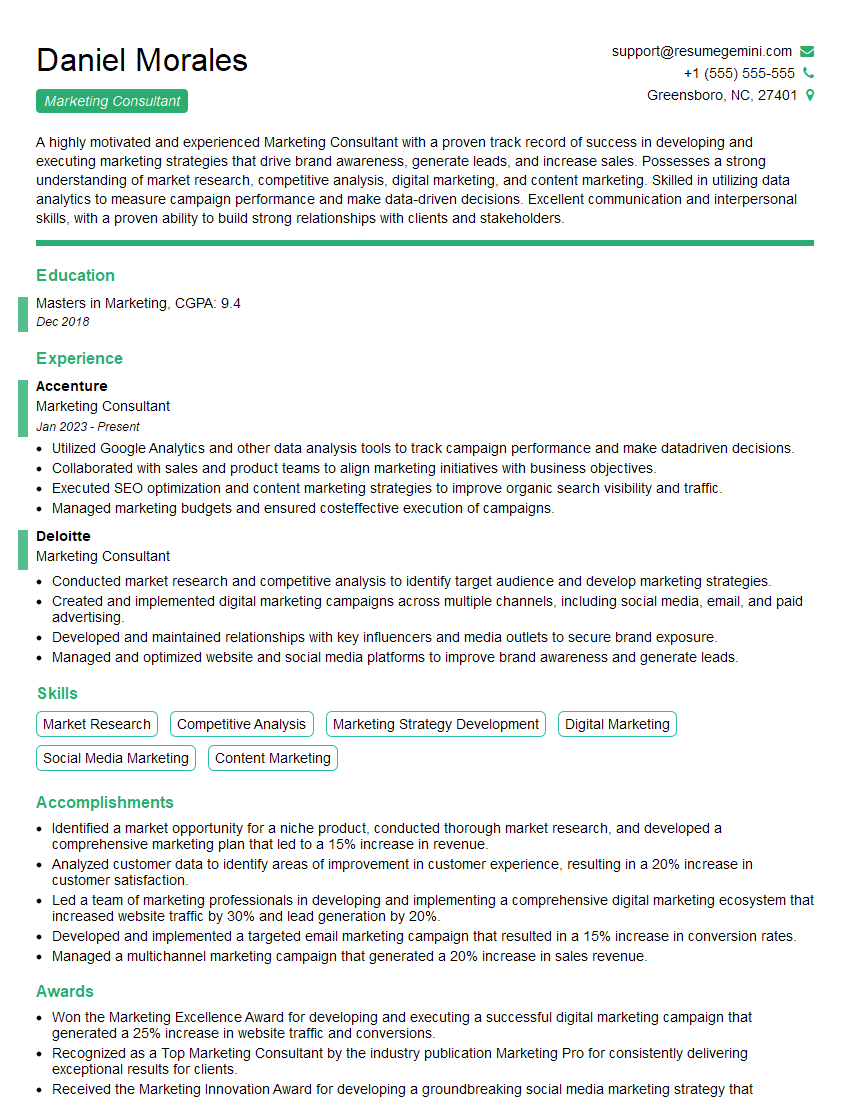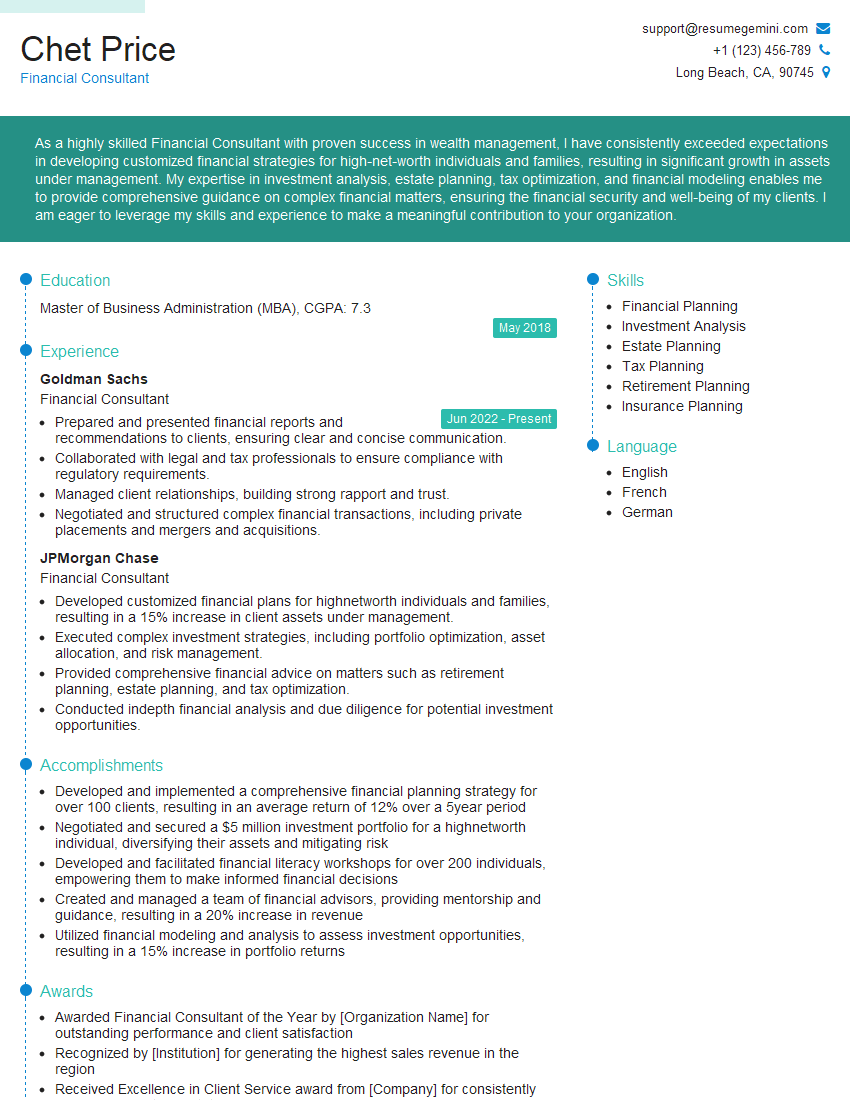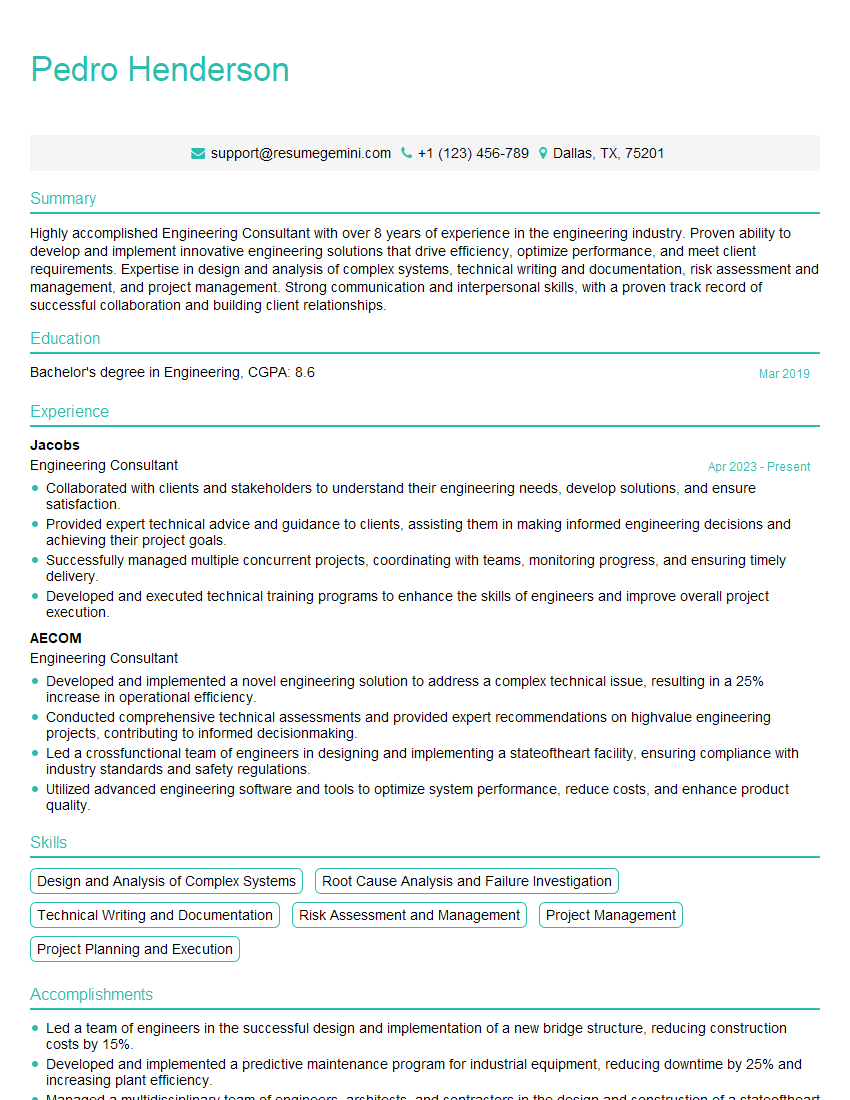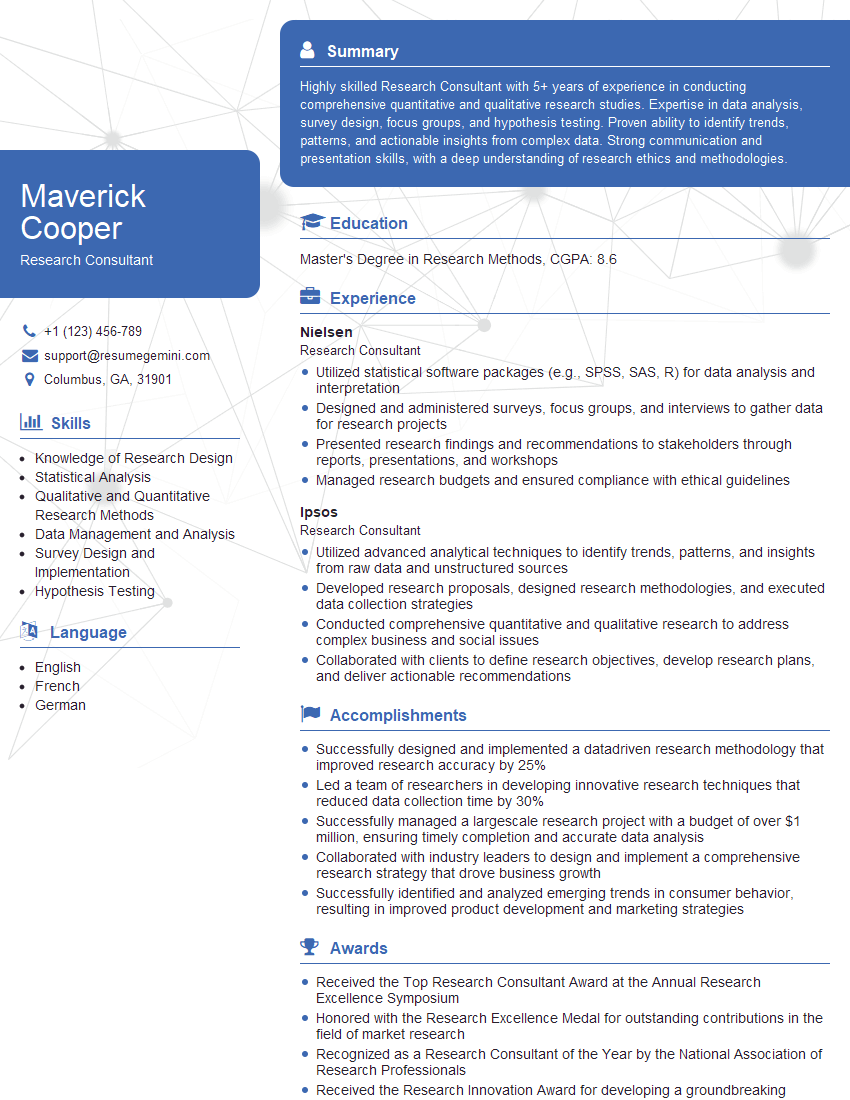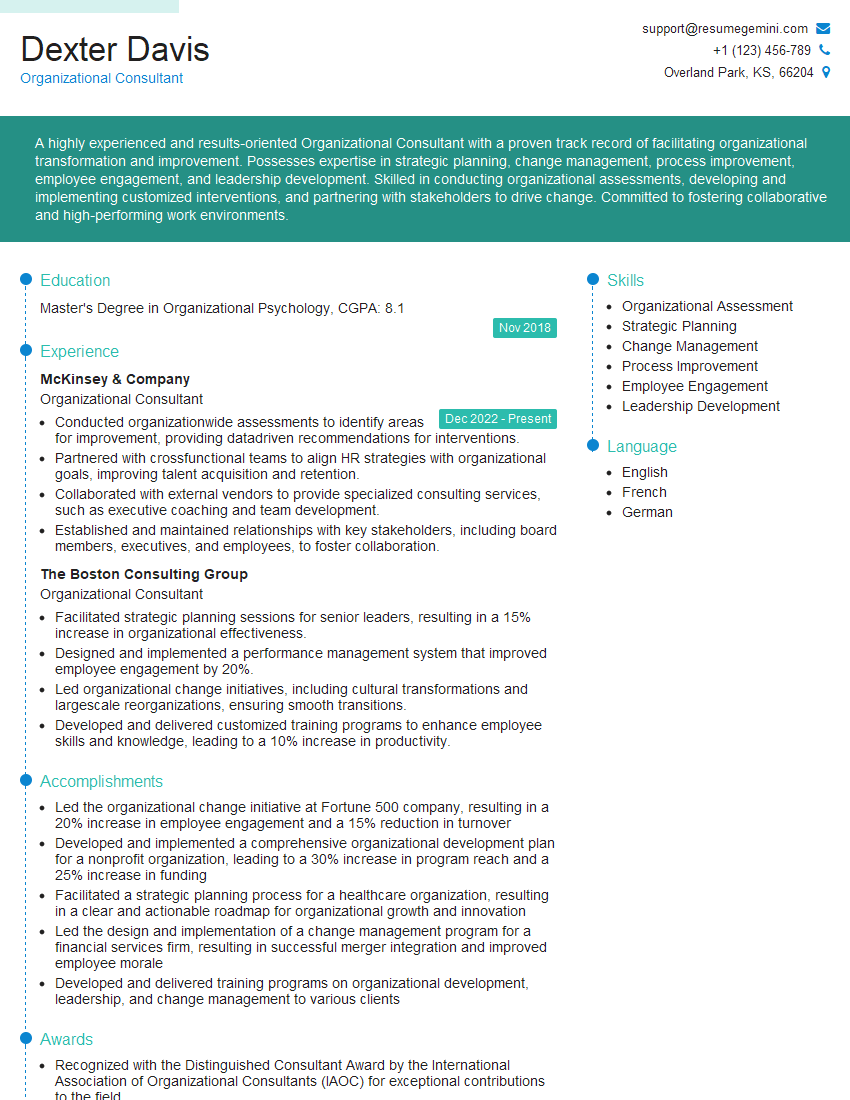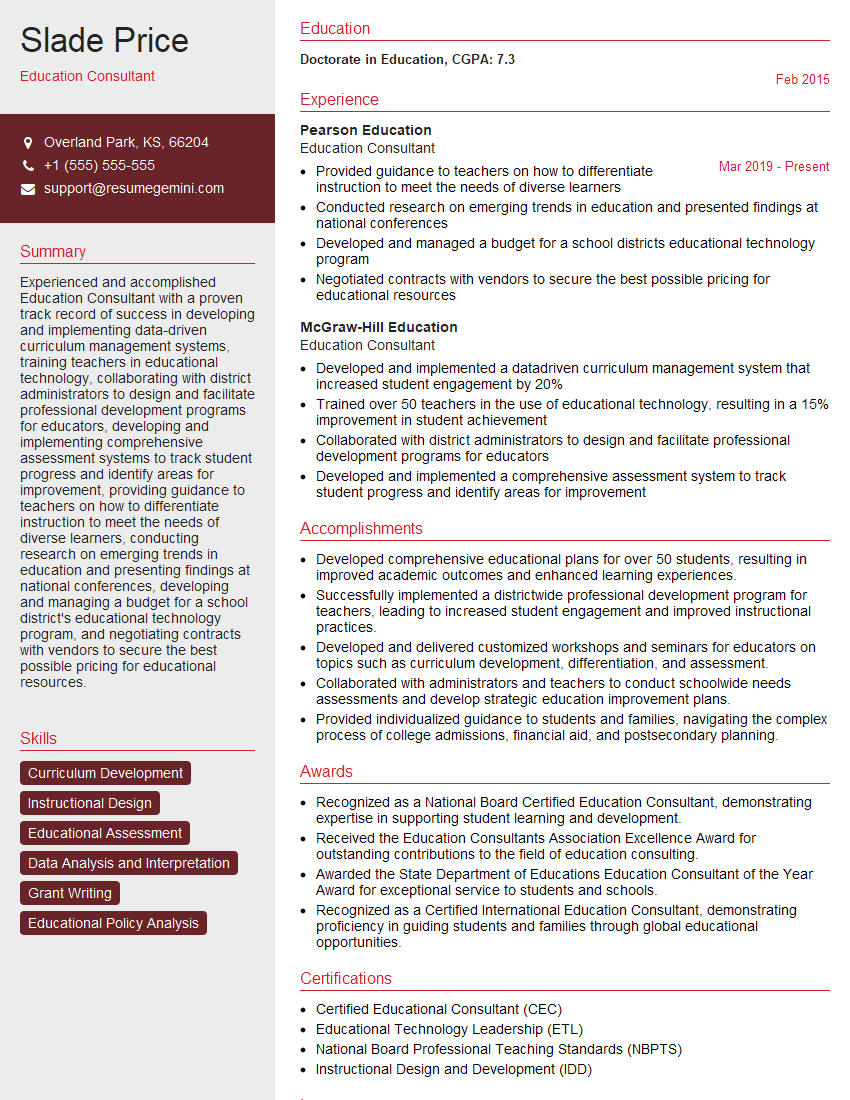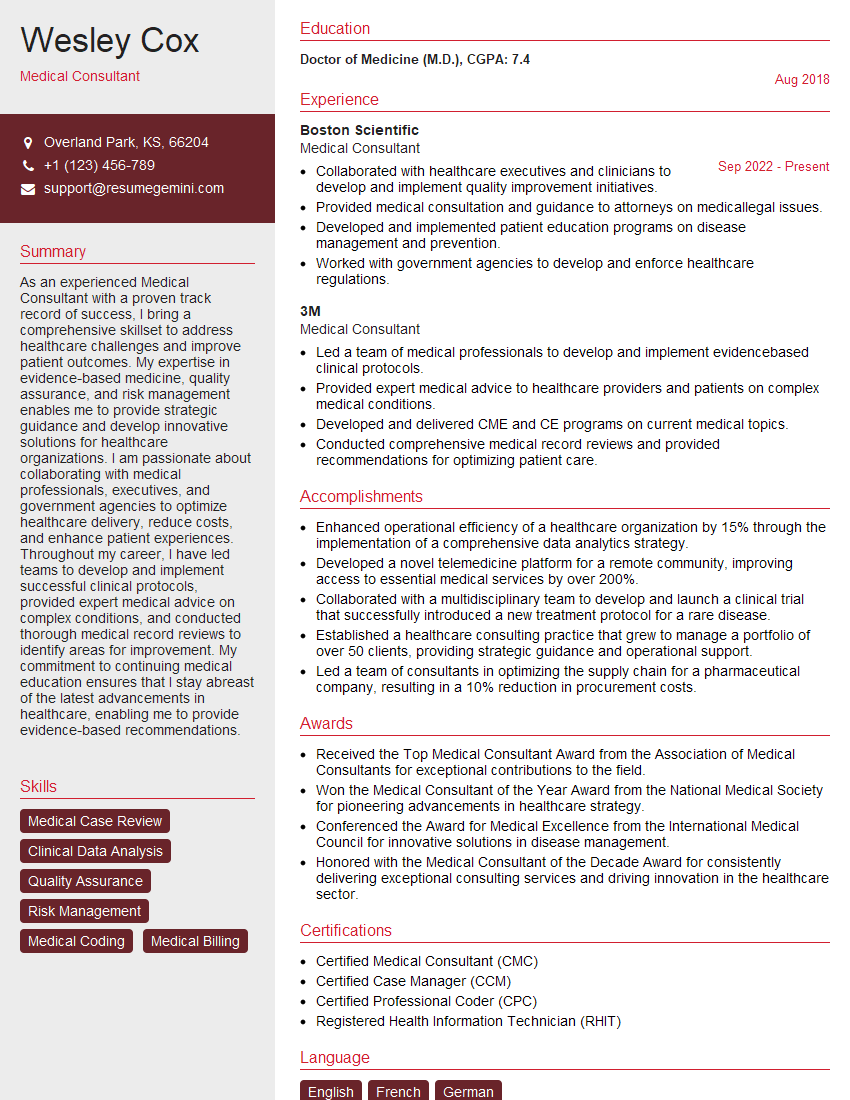The right preparation can turn an interview into an opportunity to showcase your expertise. This guide to Consultation and Collaboration with Interdisciplinary Team interview questions is your ultimate resource, providing key insights and tips to help you ace your responses and stand out as a top candidate.
Questions Asked in Consultation and Collaboration with Interdisciplinary Team Interview
Q 1. Describe your experience working with interdisciplinary teams.
My experience working with interdisciplinary teams spans over a decade, encompassing projects in healthcare, technology, and environmental science. I’ve consistently found that the most successful collaborations leverage the diverse expertise within the team to achieve a holistic outcome that’s greater than the sum of its parts. For example, in a recent project involving the development of a telehealth platform for remote patient monitoring, our team included software engineers, medical professionals, user experience designers, and data analysts. Each member contributed unique perspectives and skills, ultimately leading to a more user-friendly, clinically sound, and technologically robust product than could have been achieved by a single disciplinary team.
I’ve witnessed firsthand how diverse teams can tackle complex problems more effectively, as different viewpoints challenge assumptions and expose potential blind spots. However, success also requires strong communication and a well-defined process for managing the inherent complexities that arise from a multidisciplinary approach. This is something I’ve actively honed throughout my career.
Q 2. How do you facilitate communication and collaboration among diverse team members?
Facilitating communication and collaboration in diverse teams requires a multi-pronged approach. Firstly, establishing clear communication protocols is vital. This includes regular meetings using a structured agenda, employing efficient communication tools like project management software, and encouraging open dialogue. I typically start by defining communication preferences and establishing clear channels for various levels of discussion (e.g., quick questions via instant messaging, detailed discussions via email or video calls).
Secondly, I prioritize building trust and rapport among team members. This is achieved through team-building activities, fostering a culture of mutual respect, and actively celebrating individual and collective successes. Building trust lays the foundation for open communication and a collaborative spirit, encouraging individuals to comfortably voice their opinions and concerns.
Finally, I regularly check for understanding and actively solicit feedback to ensure everyone is on the same page. This is done through regular check-ins, feedback sessions, and ensuring transparent access to project documentation and progress reports.
Q 3. Explain your approach to conflict resolution within an interdisciplinary team.
My approach to conflict resolution emphasizes collaborative problem-solving rather than adversarial debate. When conflict arises, I focus on understanding the root cause, rather than just addressing the surface-level symptoms. This often involves active listening, encouraging each member to fully express their perspective without interruption, and facilitating a discussion that focuses on shared goals and objectives.
I employ a structured approach that incorporates these steps: 1) Identifying the conflict, 2) Defining the problem clearly and objectively, 3) Identifying the interests of all parties involved, 4) Generating creative solutions collaboratively, 5) Evaluating the options, and 6) Implementing and monitoring the agreed-upon solution. Where necessary, I facilitate mediation, ensuring a fair and impartial process. The goal is not just to resolve the immediate conflict, but to build stronger working relationships and prevent future conflicts.
For example, in one project, two team members had strongly opposing views on the best software architecture. Instead of forcing a decision, I facilitated a workshop where each member presented their rationale, highlighting the pros and cons of each approach. Through this process, the team arrived at a hybrid solution that incorporated the best aspects of each proposal.
Q 4. How do you manage differing opinions and perspectives during a collaborative project?
Managing differing opinions and perspectives is crucial for successful interdisciplinary collaboration. I see these differences not as obstacles, but as valuable resources that contribute to a more robust and innovative outcome. My strategy relies on creating a safe space for open discussion, where team members feel comfortable expressing their views without fear of judgment or reprisal. I encourage respectful debate, and facilitate structured discussions that guide the team towards a shared understanding.
I often use visual aids like mind maps or flowcharts to represent different perspectives and identify areas of common ground. This helps to move beyond abstract debate towards tangible solutions. Moreover, I ensure that all perspectives are documented and considered, even if they aren’t ultimately incorporated into the final decision. This transparency demonstrates respect for individual contributions and reinforces the importance of diverse input.
Q 5. Describe a time you had to navigate differing priorities among team members.
During a project focused on developing a new sustainable energy initiative, the engineering team prioritized speed of development, while the environmental science team emphasized a thorough environmental impact assessment. This created a conflict, as the former’s approach risked compromising the latter’s priorities. I initiated a series of meetings involving representatives from both teams. We clearly defined the project goals and milestones, acknowledging the importance of both speed and environmental responsibility.
Through collaborative problem-solving, we identified a phased approach. The first phase focused on a rapid prototype for proof-of-concept, enabling the engineering team to address their time constraints. Simultaneously, the environmental impact assessment was conducted in parallel, informing subsequent iterations of the design. This approach satisfied both teams’ priorities, demonstrating the power of compromise and careful planning in resolving conflicting priorities within an interdisciplinary team.
Q 6. How do you ensure all team members understand project goals and objectives?
Ensuring everyone understands the project goals and objectives is foundational to effective collaboration. I employ a multi-faceted approach starting with a clearly articulated project charter that defines the overall aims, scope, and deliverables. This document is then broken down into smaller, more manageable tasks with clearly defined roles and responsibilities. Regular project meetings are essential for reviewing progress, addressing questions, and ensuring everyone remains aligned.
I leverage visual aids such as Gantt charts or Kanban boards to represent project timelines and dependencies, making it easier for everyone to understand the project’s flow and their individual contributions. Furthermore, I utilize various communication tools, including project management software and regular email updates, to keep everyone informed about progress and changes. Open communication channels ensure that questions and concerns can be addressed promptly, preventing misunderstandings and maintaining team cohesion.
Q 7. What strategies do you employ to build consensus among team members?
Building consensus involves fostering a collaborative environment where everyone feels valued and respected. I utilize several strategies to achieve this, including collaborative problem-solving techniques, such as brainstorming and SWOT analysis. These methods encourage participation from all team members and generate a shared understanding of the challenges and opportunities. I also use techniques like nominal group technique or Delphi method for situations requiring a structured approach to reaching a consensus, especially when dealing with complex or controversial issues.
Crucially, I ensure that all voices are heard, and I actively manage potential power imbalances within the team. This includes encouraging quiet or less assertive members to participate, and making sure that dominant voices don’t overshadow others. I ensure that decisions reflect a balanced consideration of all perspectives, even if not every member completely agrees with the final outcome. The focus is on building buy-in and commitment to the agreed-upon direction.
Q 8. How do you identify and leverage the strengths of each team member?
Identifying and leveraging team member strengths is crucial for effective interdisciplinary collaboration. I begin by employing a combination of methods, including initial team meetings where each member outlines their skills and experience, reviewing previous work samples or portfolios, and directly observing contributions during early project phases. This helps me gain a comprehensive understanding of everyone’s capabilities.
For example, in a recent project involving the design of a new sustainable building, one team member demonstrated exceptional expertise in energy-efficient materials, while another excelled at architectural design software. Recognizing these strengths, I tailored tasks accordingly, empowering each individual to focus on their area of proficiency. This resulted in a higher quality output and improved team morale.
To leverage these strengths further, I actively encourage collaboration between team members with complementary skillsets. This promotes knowledge sharing and allows team members to learn from each other, fostering a more robust and innovative approach.
Q 9. How do you address the challenges of working with individuals from different professional backgrounds?
Working with diverse professional backgrounds presents unique challenges, but it also fosters creativity and innovation. The key is effective communication and mutual understanding. I address these challenges by establishing clear communication protocols from the outset, promoting active listening, and establishing a culture of respect for differing perspectives. It’s also vital to clearly define roles and responsibilities to avoid duplication of effort and ensure everyone understands their contribution to the overall project goals.
For instance, I might facilitate workshops where team members from different disciplines (e.g., engineers, architects, and environmental scientists) can share their perspectives on a given problem. This structured approach enables efficient knowledge transfer and helps to bridge communication gaps. Furthermore, I utilize visual aids and project management software to ensure everyone is on the same page regarding project timelines, deliverables, and shared goals. This helps to minimize misunderstandings and conflicts.
Q 10. Describe your experience using collaboration tools and technologies.
My experience with collaboration tools and technologies is extensive. I’m proficient in various platforms, including project management software like Asana and Trello, communication tools such as Slack and Microsoft Teams, and collaborative document editing platforms like Google Docs and Microsoft SharePoint. I choose the most appropriate technology based on the project’s specific needs and the team’s preferences.
In a recent project, we utilized Asana to track tasks, deadlines, and individual responsibilities. Slack served as our primary communication channel for quick updates and discussions. Google Docs facilitated collaborative document creation and editing, ensuring everyone had access to the most up-to-date information. This integrated approach significantly streamlined our workflow and improved transparency.
Q 11. How do you track progress and ensure accountability within a collaborative environment?
Tracking progress and ensuring accountability are vital for successful interdisciplinary collaboration. I typically employ a combination of methods to achieve this. First, a detailed project plan with clearly defined milestones and deadlines is crucial. This serves as a roadmap for the project and keeps the team focused on key objectives.
Second, regular progress meetings, utilizing tools like video conferencing or in-person meetings, provide a forum for team members to update on their progress, identify any roadblocks, and discuss solutions. These meetings allow for early detection of any potential issues and provide opportunities for course correction. Finally, I leverage project management software to monitor individual task completion, flag potential delays, and ensure that everyone is meeting their commitments.
For example, in one project, we used a Kanban board within Asana to visually track task progress. This transparency allowed team members to easily monitor their own work and identify dependencies between tasks. Weekly progress reports were also submitted, summarizing achievements and highlighting any challenges encountered.
Q 12. Explain your process for documenting and sharing project information among team members.
Documenting and sharing project information effectively is paramount for efficient collaboration. I employ a centralized system, typically a shared online repository like a SharePoint site or a dedicated project folder on a cloud storage platform. All project documents, meeting minutes, progress reports, and communication records are stored here, ensuring easy access for all team members.
To ensure clarity and organization, I establish a clear naming convention for files and folders. Version control is also important to avoid confusion and track changes to documents. Regular communication reminds team members to utilize the centralized system and update relevant information. This prevents information silos and fosters transparency.
Q 13. How do you assess the effectiveness of your interdisciplinary team’s performance?
Assessing the effectiveness of an interdisciplinary team’s performance requires a multifaceted approach. I employ a combination of quantitative and qualitative measures. Quantitative measures include project completion rates, adherence to deadlines, and budget management. Qualitative measures involve gathering feedback from team members through surveys, individual meetings, and post-project reviews.
Furthermore, I analyze the quality of the final product or service and assess the level of collaboration and communication within the team. Metrics such as team satisfaction scores and feedback on the effectiveness of team processes provide valuable insights. These data points collectively provide a comprehensive picture of the team’s performance and identify areas for improvement.
Q 14. How do you adapt your communication style to effectively work with diverse personalities?
Adapting communication style to diverse personalities is crucial for effective collaboration. I believe in understanding individual communication preferences and tailoring my approach accordingly. This involves being mindful of verbal and non-verbal cues, adjusting the level of formality as needed, and being sensitive to cultural differences.
For example, I might communicate with more direct, task-oriented language with some team members who prefer efficiency, while utilizing a more collaborative, discussion-based approach with others who benefit from a more participatory style. Active listening is crucial in understanding how each team member prefers to receive and process information. Regularly checking for understanding and seeking feedback helps to ensure everyone feels heard and respected.
Q 15. Describe a time you had to mediate a disagreement between team members.
Mediating disagreements requires a neutral stance and active listening. I approach such situations by first ensuring a safe and respectful environment for all parties involved. This might involve scheduling a private meeting in a neutral location to reduce tension. My goal is to understand each person’s perspective without judgment. I employ active listening techniques, summarizing each viewpoint to confirm understanding and ensure everyone feels heard.
For example, during a project involving a software engineer and a marketing specialist, a disagreement arose regarding the functionality of a new feature. The engineer prioritized technical efficiency while the marketing team wanted user-friendly features. I facilitated a discussion where each side explained their perspective, identified common goals, and collaboratively found compromises. We used a whiteboard to brainstorm solutions, ultimately agreeing on a plan that balanced both technical feasibility and user experience. The key was to focus on shared objectives, finding common ground, and reframing the conflict as a problem-solving opportunity rather than a personal disagreement.
Career Expert Tips:
- Ace those interviews! Prepare effectively by reviewing the Top 50 Most Common Interview Questions on ResumeGemini.
- Navigate your job search with confidence! Explore a wide range of Career Tips on ResumeGemini. Learn about common challenges and recommendations to overcome them.
- Craft the perfect resume! Master the Art of Resume Writing with ResumeGemini’s guide. Showcase your unique qualifications and achievements effectively.
- Don’t miss out on holiday savings! Build your dream resume with ResumeGemini’s ATS optimized templates.
Q 16. How do you handle situations where team members are not meeting expectations?
Addressing underperformance involves a structured, supportive approach. I begin by scheduling a private meeting to discuss performance openly and honestly. This is not a blame session, but rather a collaborative effort to identify the root cause of the problem. I use the Situation-Behavior-Impact (SBI) model, which helps frame the issue without making personal attacks. I ask open-ended questions to understand the challenges the team member is facing. Are there skill gaps? Are there resource constraints? Is there a lack of clarity regarding expectations?
For example, if a team member consistently misses deadlines, I would use the SBI model to discuss specific instances, the behaviors that led to the missed deadlines (e.g., underestimation of time, lack of prioritization), and the impact on the project. Together, we would explore possible solutions, such as additional training, adjusted workload, or improved time management strategies. Regular check-ins and performance monitoring would follow, providing support and accountability. The goal is to help the team member succeed, and ultimately, to support the team’s success.
Q 17. Describe your experience in facilitating workshops or meetings with diverse groups.
Facilitating workshops and meetings with diverse groups demands strong organizational and interpersonal skills. I begin by creating a structured agenda that is shared in advance. This ensures everyone is aware of the objectives and the expected outcomes. I utilize various inclusive facilitation techniques to encourage participation from all members. This includes using a variety of communication methods (visual aids, open discussions, breakout groups), ensuring equitable speaking time, and actively addressing any power imbalances within the group.
In a recent cross-functional workshop involving designers, developers, and marketing professionals, I employed a “World Café” style discussion. This allowed smaller groups to focus on specific topics and then share their findings with the larger group, generating a rich discussion. The visual aids used (mind maps, sticky notes) encouraged participation from visual learners and fostered a collaborative atmosphere. The structured approach ensured efficient use of time and a productive outcome.
Q 18. How do you contribute to a positive and inclusive team environment?
Building a positive and inclusive team environment requires conscious effort and consistent action. I promote open communication by encouraging regular feedback sessions, both formal and informal. This allows team members to share ideas, concerns, and challenges openly without fear of judgment. I actively acknowledge and celebrate individual and team accomplishments. Recognizing contributions boosts morale and fosters a sense of shared success.
I also champion diversity and inclusion by ensuring that everyone feels valued and respected. This means being mindful of potential biases, promoting equal opportunities, and actively seeking out diverse perspectives. Creating a culture of psychological safety—where team members feel comfortable taking risks and expressing dissenting opinions—is paramount.
Q 19. How do you ensure that all voices are heard and valued within the team?
Ensuring all voices are heard and valued demands intentional strategies. I use a variety of techniques to encourage participation, such as round-robin discussions, brainstorming sessions with anonymous idea collection, and breakout groups tailored to individual skills and perspectives. I actively manage participation, ensuring that quieter members have opportunities to contribute, and that dominant voices don’t overshadow others. I utilize active listening techniques to fully grasp each perspective before moving on.
For example, in a team meeting where one individual tends to dominate conversations, I might strategically ask others for their opinions, using phrases like, “I haven’t heard from [name] yet, what are your thoughts?” I also explicitly state my intention to create a safe space for everyone to share their views, reinforcing the value of diverse input.
Q 20. How do you balance individual contributions with overall team goals?
Balancing individual contributions with overall team goals is achieved through clear communication, shared understanding of objectives, and regular progress tracking. Individual goals must align with overall team objectives to avoid siloed work and maximize collective impact. This requires open communication about individual capacities, limitations and aspirations. Individual goals should be specific, measurable, achievable, relevant, and time-bound (SMART) and collaboratively established.
For example, I would encourage team members to explicitly link their individual task lists to larger project milestones during planning sessions. This ensures transparency and accountability, fostering a shared understanding of how individual work contributes to overall success. Regular progress updates and team meetings provide opportunities to adjust strategies as needed, preventing individual contributions from drifting too far from the team’s goals.
Q 21. Describe your experience in developing and implementing collaborative project plans.
Developing and implementing collaborative project plans involves a structured, iterative process. I typically start by clearly defining project goals, objectives, and deliverables. I then involve the team in defining tasks, assigning responsibilities, and establishing timelines using collaborative project management tools. These tools facilitate communication, task tracking, and progress monitoring. Regular team meetings are scheduled to discuss progress, address challenges, and adjust the plan as needed.
For example, I might use a project management tool like Jira to create a Kanban board, allowing for visual tracking of tasks and workflows. This promotes transparency and facilitates communication. The collaborative nature of the tool encourages participation from all team members, ensuring buy-in and accountability. Regular sprint reviews and retrospectives provide opportunities for feedback and process improvement.
Q 22. How do you manage timelines and resources in a collaborative project?
Managing timelines and resources in collaborative projects requires a proactive and organized approach. It’s not just about creating a Gantt chart; it’s about fostering a shared understanding and commitment to the schedule and available resources.
My process typically involves:
- Collaborative Planning: I begin by working with the team to create a realistic project timeline, breaking down large tasks into smaller, manageable components. This involves identifying dependencies between tasks and assigning realistic durations. We use tools like Trello or Asana to visualize the workflow and track progress.
- Resource Allocation: Next, we identify the resources needed – personnel, budget, equipment, software – for each task. We assess the availability of each resource and allocate them effectively, considering individual skill sets and potential conflicts.
- Regular Monitoring and Adjustment: Throughout the project, we regularly track progress against the timeline. We hold regular meetings to identify any roadblocks or delays. If necessary, we collaboratively adjust the timeline or resource allocation to stay on track. This often involves re-prioritizing tasks or seeking additional resources if needed. Transparency is key.
- Risk Mitigation Planning: We proactively identify potential delays or resource constraints during the planning phase, and we develop contingency plans to address these risks.
For example, in a recent project involving the design of a new medical device, we used a Kanban board to visualize task progress and resource allocation. This allowed us to quickly identify bottlenecks and re-allocate resources accordingly, preventing delays.
Q 23. Explain your process for identifying and mitigating risks within a collaborative project.
Identifying and mitigating risks in collaborative projects is crucial for success. My approach is systematic and proactive, focusing on early identification and collaborative risk management.
My process includes:
- Risk Identification: We brainstorm potential risks throughout the project lifecycle, leveraging the diverse expertise of the interdisciplinary team. We use techniques like SWOT analysis and brainstorming sessions to identify potential problems, ranging from technical challenges to communication breakdowns.
- Risk Analysis: Once risks are identified, we assess their likelihood and potential impact. This allows us to prioritize risks based on their severity.
- Risk Mitigation Planning: For each high-priority risk, we develop a mitigation strategy. This might involve developing contingency plans, assigning responsibility for risk management to specific team members, or securing additional resources.
- Monitoring and Review: We regularly monitor risks throughout the project. If new risks emerge, or existing risks change in likelihood or impact, we reassess and adapt our mitigation strategies.
For instance, in a software development project, we identified a potential risk related to integration with a third-party API. We mitigated this risk by building a robust testing plan and establishing clear communication channels with the API provider.
Q 24. How do you ensure that project decisions are well-informed and supported by evidence?
Ensuring well-informed, evidence-based project decisions is paramount. This involves creating a culture of transparency, data-driven analysis, and collaborative decision-making.
My strategies include:
- Data Collection and Analysis: We collect relevant data throughout the project, using appropriate methods such as surveys, experiments, and data analysis. This data is used to inform decisions and track progress.
- Evidence-Based Discussion: During meetings and discussions, we focus on using data and evidence to support claims and recommendations. This promotes objective decision-making and reduces reliance on intuition or personal biases.
- Transparent Decision-Making Process: We establish a clear process for making decisions, ensuring that all stakeholders have a voice and understand the reasoning behind decisions. This might involve voting, consensus building, or a combination of methods.
- Documentation and Tracking: We meticulously document all decisions made, the evidence used to support them, and the rationale behind them. This creates a clear audit trail and supports continuous learning and improvement.
In a recent public health initiative, we used epidemiological data to inform resource allocation and intervention strategies, leading to a more effective and impactful program.
Q 25. Describe a time you successfully collaborated with an interdisciplinary team to solve a complex problem.
During a project to improve patient flow in a hospital emergency department, I collaborated with a team including nurses, doctors, administrators, and IT specialists. The problem was significant patient wait times and overcrowding.
Our approach involved:
- Defining the Problem: We began by clearly defining the problem, gathering data on wait times, patient flow, and resource utilization. We held several brainstorming sessions to understand the root causes.
- Identifying Solutions: The interdisciplinary nature of the team was invaluable. Nurses highlighted workflow bottlenecks, doctors pointed out areas for improved triage, administrators identified resource limitations, and the IT team proposed solutions for improving data collection and communication.
- Implementing and Evaluating Solutions: We implemented several solutions in phases, including improved triage protocols, a new patient registration system, and optimized staffing schedules. We continuously monitored the impact of each solution, making adjustments as needed.
The project was successful in significantly reducing patient wait times and improving overall emergency department efficiency. The success was directly attributed to the effective collaboration and the contribution of each team member’s unique expertise.
Q 26. How do you measure the success of a collaborative project?
Measuring the success of a collaborative project requires a multi-faceted approach, going beyond simply completing the project on time and within budget. We need to assess whether we achieved our intended goals and improved outcomes.
My approach involves:
- Pre-defined Metrics: Before starting the project, we clearly define key performance indicators (KPIs) that align with the project’s goals. These metrics should be measurable, achievable, relevant, and time-bound (SMART).
- Data Collection and Analysis: Throughout the project, we collect data related to the KPIs. This data is analyzed to track progress and assess the effectiveness of the project.
- Qualitative Feedback: In addition to quantitative data, we gather qualitative feedback from stakeholders, including team members, clients, and beneficiaries. This feedback provides valuable insights into the project’s impact and areas for improvement.
- Post-Project Review: After the project is completed, we conduct a thorough review to assess the project’s overall success, identify lessons learned, and document best practices.
For example, in a community health program, we measured success based on increased participation rates, improved health outcomes, and stakeholder satisfaction.
Q 27. How do you foster a culture of continuous improvement within an interdisciplinary team?
Fostering a culture of continuous improvement in an interdisciplinary team requires a commitment to learning, reflection, and adaptation.
My strategies include:
- Regular Feedback Sessions: We regularly hold feedback sessions where team members can share their experiences, identify areas for improvement, and provide constructive criticism. This fosters a culture of open communication and trust.
- Lessons Learned Reviews: After each project phase or the entire project, we conduct a lessons learned review to identify what went well, what could be improved, and how to incorporate these lessons into future projects.
- Knowledge Sharing Platforms: We establish platforms for sharing knowledge and best practices, such as internal wikis, online forums, or shared document repositories. This allows team members to learn from each other’s experiences.
- Training and Development: We provide opportunities for team members to enhance their skills and knowledge through training, workshops, or conferences. This ensures the team remains current with best practices and emerging technologies.
For instance, we established a monthly “improvement meeting” where we discussed challenges and identified process improvements within our team.
Q 28. What are your preferred methods for facilitating knowledge sharing within an interdisciplinary team?
Facilitating knowledge sharing within an interdisciplinary team is crucial for collaboration and project success. My preferred methods are diverse and cater to different learning styles and preferences.
My strategies include:
- Regular Team Meetings: Structured meetings with clear agendas provide a dedicated space for knowledge sharing and discussion. This allows team members to share updates, challenges, and best practices.
- Knowledge Management Systems: We utilize collaborative platforms such as shared drives, wikis, or project management software to centralize project information, documents, and best practices. This ensures that information is easily accessible to all team members.
- Mentorship Programs: Pairing experienced team members with less experienced ones provides opportunities for knowledge transfer and skill development. This fosters a supportive learning environment.
- Workshops and Training Sessions: Targeted workshops or training sessions address specific knowledge gaps and skill development needs within the team, improving overall team competence.
- Cross-Training Opportunities: Encouraging team members to work on different aspects of projects allows for knowledge sharing and skill development across disciplines. This fosters team cohesion and prevents departmental silos.
For example, in a recent project, we created a shared online document repository to store all project-related materials. This ensured that every team member had access to the most up-to-date information.
Key Topics to Learn for Consultation and Collaboration with Interdisciplinary Team Interview
- Understanding Interdisciplinary Dynamics: Explore the strengths and challenges of working with professionals from diverse backgrounds and expertise. Consider communication styles and potential conflicts.
- Effective Communication Strategies: Practice conveying complex information clearly and concisely to different audiences. Develop active listening skills and techniques for conflict resolution.
- Collaboration Tools and Techniques: Familiarize yourself with project management methodologies (Agile, Scrum, etc.) and collaborative platforms (e.g., shared document editing, project management software). Practice explaining your role within a team workflow.
- Conflict Resolution and Negotiation: Learn strategies for identifying and addressing disagreements constructively. Practice mediation techniques and approaches to compromise.
- Ethical Considerations: Understand the ethical implications of collaborating with interdisciplinary teams, particularly regarding data privacy, intellectual property, and professional boundaries.
- Practical Application: Prepare examples from your experience (academic projects, volunteer work, previous jobs) that showcase your successful collaboration in diverse team environments. Be ready to discuss specific challenges and how you overcame them.
- Problem-solving in a Team Setting: Practice brainstorming and problem-solving collaboratively. Be able to articulate your role in a team’s problem-solving process and decision-making.
Next Steps
Mastering consultation and collaboration with interdisciplinary teams is crucial for career advancement in today’s complex work environments. It demonstrates essential soft skills highly valued by employers across various industries. To significantly increase your job prospects, focus on creating a strong, ATS-friendly resume that highlights your relevant skills and experiences. ResumeGemini is a trusted resource that can help you build a professional and impactful resume tailored to your unique skills and career goals. Examples of resumes tailored to showcasing expertise in Consultation and Collaboration with Interdisciplinary Teams are available within the ResumeGemini platform.
Explore more articles
Users Rating of Our Blogs
Share Your Experience
We value your feedback! Please rate our content and share your thoughts (optional).
What Readers Say About Our Blog
This was kind of a unique content I found around the specialized skills. Very helpful questions and good detailed answers.
Very Helpful blog, thank you Interviewgemini team.

